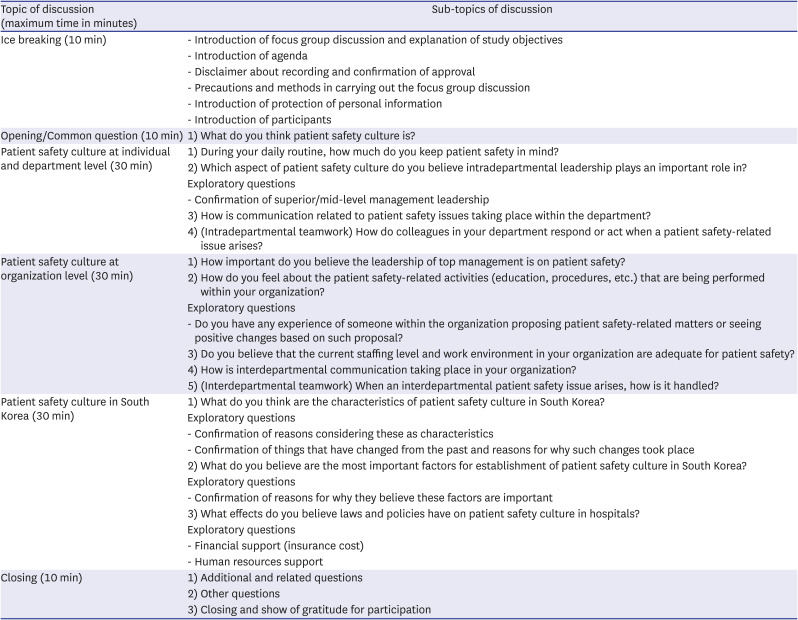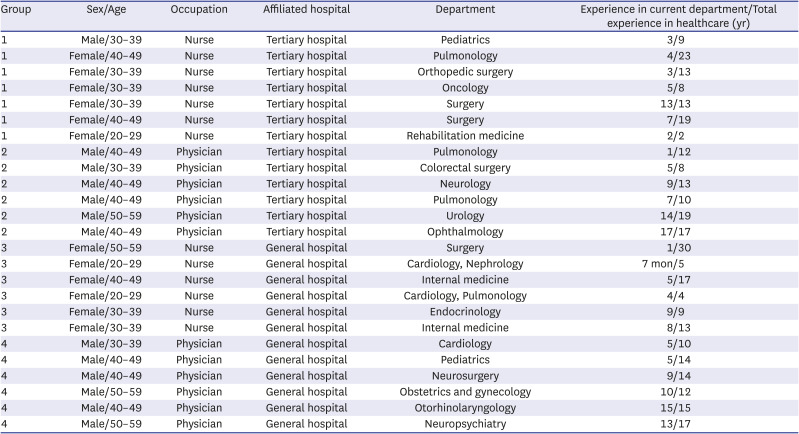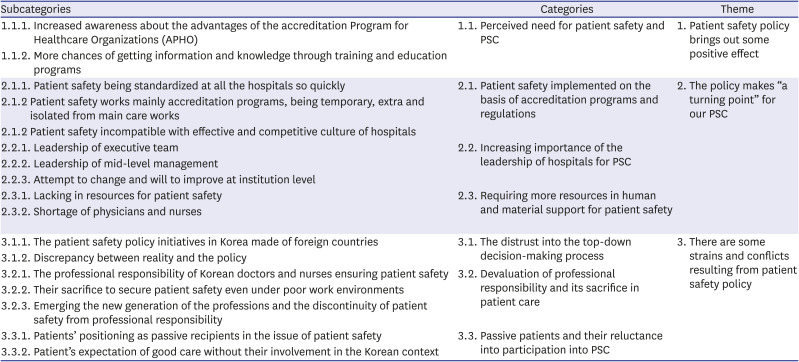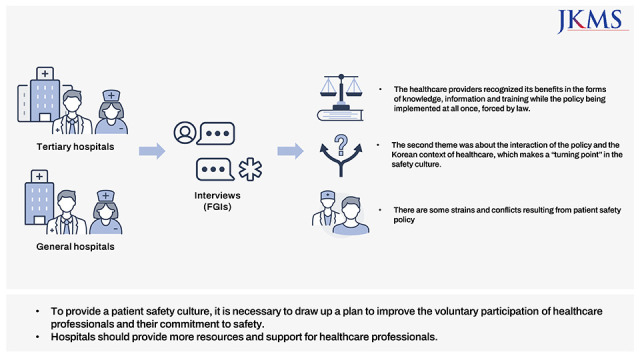1. Levison A. Patient safety. Anaesthesia. 2003; 58(12):1236.

2. Reason J. Human error: models and management. BMJ. 2000; 320(7237):768–770. PMID:
10720363.

3. Health and Safety Commission. Organizing for Safety: Third Report of the Human Factors Study Group of ACSNI. Sudbury, UK: HSE Books;1993.
4. Smits M, Christiaans-Dingelhoff I, Wagner C, Wal G, Groenewegen PP. The psychometric properties of the ‘Hospital Survey on Patient Safety Culture’ in Dutch hospitals. BMC Health Serv Res. 2008; 8(1):230. PMID:
18990256.

5. Singer S, Lin S, Falwell A, Gaba D, Baker L. Relationship of safety climate and safety performance in hospitals. Health Serv Res. 2009; 44(2 Pt 1):399–421. PMID:
19178583.

6. Kim KJ, Yoo MS, Seo EJ. Exploring the influence of nursing work environment and patient safety culture on missed nursing care in Korea. Asian Nurs Res. 2018; 12(2):121–126.

7. Lee W, Pyo J, Jang SG, Choi JE, Ock M. Experiences and responses of second victims of patient safety incidents in Korea: a qualitative study. BMC Health Serv Res. 2019; 19(1):100. PMID:
30728008.

8. Choi EY, Pyo J, Ock M, Lee SI. Nurses’ perceptions regarding disclosure of patient safety incidents in Korea: a qualitative study. Asian Nurs Res. 2019; 13(3):200–208.

9. World Health Organization. Global Patient Safety Action Plan 2021–2030: Towards Eliminating Avoidable Harm in Health Care. Geneva, Switzerland: World Health Organization;2021.
10. Leape L, Berwick D, Clancy C, Conway J, Gluck P, Guest J, et al. Transforming healthcare: a safety imperative. Qual Saf Health Care. 2009; 18(6):424–428. PMID:
19955451.

11. Chang HS, Lee SH. Establishment, present condition, and developmental direction of the new Korean healthcare accreditation system. J Korean Med Sci. 2012; 27(Suppl):S61–S69. PMID:
22661873.

12. El-Jardali F, Fadlallah R. A review of national policies and strategies to improve quality of health care and patient safety: a case study from Lebanon and Jordan. BMC Health Serv Res. 2017; 17(1):568. PMID:
28814341.

13. Kim MK, Kim JE, An KE, Kim Y, Kim SW. Physicians’ perception of and attitudes towards patient safety culture and medical error reporting. Health Policy Manag. 2005; 15(4):110–135.

14. Kim Y, Lee ES, Choi EY. Perception of patient safety culture of hospital nurses. Korea J Hosp Manag. 2013; 18(3):27–42.
15. Kim EK, Kim HJ, Kang MA. Experience and perception on patient safety culture of employees in hospitals. J Korean Acad Nurs Adm. 2007; 13(3):321–334.
16. Tong A, Sainsbury P, Craig J. Consolidated criteria for reporting qualitative research (COREQ): a 32-item checklist for interviews and focus groups. Int J Qual Health Care. 2007; 19(6):349–357. PMID:
17872937.

17. Halligan M, Zecevic A. Safety culture in healthcare: a review of concepts, dimensions, measures and progress. BMJ Qual Saf. 2011; 20(4):338–343.

18. Singla AK, Kitch BT, Weissman JS, Campbell EG. Assessing patient safety culture: a review and synthesis of the measurement tools. J Patient Saf. 2006; 2(3):105–115.
19. Sammer CE, Lykens K, Singh KP, Mains DA, Lackan NA. What is patient safety culture? A review of the literature. J Nurs Scholarsh. 2010; 42(2):156–165. PMID:
20618600.

20. Guba EG, Lincoln YS. Effective Evaluation. San Francisco, CA, USA: Jossey-Bass;1981.
21. Farokhzadian J, Dehghan Nayeri N, Borhani F. The long way ahead to achieve an effective patient safety culture: challenges perceived by nurses. BMC Health Serv Res. 2018; 18(1):654. PMID:
30134980.

22. Ko Y, Yu S. The relationships among perceived patients’ safety culture, intention to report errors, and leader coaching behavior of nurses in Korea: a pilot study. J Patient Saf. 2017; 13(3):175–183. PMID:
26101999.

23. Wang Y, Liu W, Shi H, Liu C, Wang Y. Measuring patient safety culture in maternal and child health institutions in China: a qualitative study. BMJ Open. 2017; 7(7):e015458.

24. Danielsson M, Nilsen P, Öhrn A, Rutberg H, Fock J, Carlfjord S. Patient safety subcultures among registered nurses and nurse assistants in Swedish hospital care: a qualitative study. BMC Nurs. 2014; 13(1):39. PMID:
25435809.

25. Danielsson M, Nilsen P, Rutberg H, Carlfjord S. The professional culture among physicians in Sweden: potential implications for patient safety. BMC Health Serv Res. 2018; 18(1):543. PMID:
29996832.

26. Lee W, Kim SY, Lee SI, Lee SG, Kim HC, Kim I. Barriers to reporting of patient safety incidents in tertiary hospitals: a qualitative study of nurses and resident physicians in South Korea. Int J Health Plann Manage. 2018; 33(4):1178–1188. PMID:
30160794.

27. Liu C, Liu W, Wang Y, Zhang Z, Wang P. Patient safety culture in China: a case study in an outpatient setting in Beijing. BMJ Qual Saf. 2014; 23(7):556–564.

28. Wami SD, Demssie AF, Wassie MM, Ahmed AN. Patient safety culture and associated factors: a quantitative and qualitative study of healthcare workers’ view in Jimma zone Hospitals, Southwest Ethiopia. BMC Health Serv Res. 2016; 16(1):495. PMID:
27644960.

29. Tomazoni A, Rocha PK, Ribeiro MB, Serapião LS, Souza S, Manzo BF. Perception of nursing and medical professionals on patient safety in neonatal intensive care units. Rev Gaúcha Enferm. 2017; 38(1):e64996. PMID:
28658397.







 PDF
PDF Citation
Citation Print
Print




 XML Download
XML Download